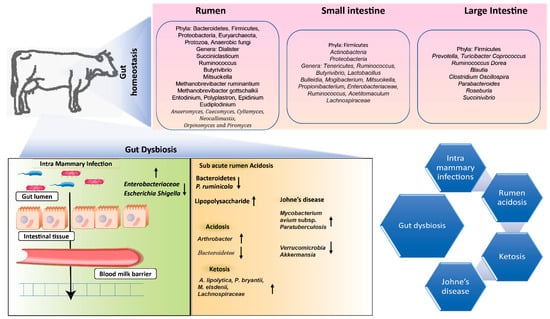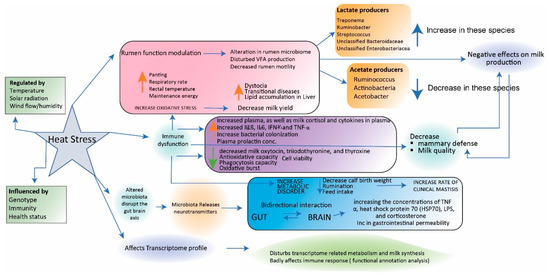Within the ruminant intestines, a diverse array of microbiota predominates, predominantly comprised of bacteria with a specialized role in breaking down intricate nutrients like cellulose and hemicellulose. This breakdown results in the conversion of these complex compounds into simpler constituents, such as glucose, which ultimately facilitates the assimilation of nutrients. The composition of these microbial communities within the rumen is contingent on a multitude of factors. These include breed, age, external environment, diet, and nutritional factors. Moreover, other variables, such as the process of weaning, energy requirements, and the presence of potentially toxic metabolic byproducts, can also exert an impact on the microbial composition and abundance within the rumen. External factors, including heat stress, psychological stress, environmental conditions, and dietary patterns, can likewise pose threats to the stability of rumen microflora.
1. Introductions
Maintaining proper homeostasis of the rumen microflora stands as a crucial aspect. Their presence in optimal quantities is indispensable, as they exert a substantial influence on the host’s physiological state and play a notable role in methane production
[1][2][63,65]. The composition of these microbial communities within the rumen is contingent on a multitude of factors. These include breed, age, external environment, diet, and nutritional factors
[3][4][9,42]. Moreover, other variables, such as the process of weaning, energy requirements, and the presence of potentially toxic metabolic byproducts, can also exert an impact on the microbial composition and abundance within the rumen. External factors, including heat stress, psychological stress, environmental conditions, and dietary patterns, can likewise pose threats to the stability of rumen microflora
[5][66].
Amidst the multitude of influential factors, diet emerges as a prominent determinant that governs the composition of the microbiota. This role is particularly evident in the context of the temporal changes occurring in the rumen microbiome of neonatal calves
[6][7][30,67]. For instance, consider the rumen component of three-week-old calves fed with milk replacer, alongside supplementation of a neonatal crude starter ration containing 20% protein, 3% fat, and 5.7% fiber. In this scenario, a relatively uniform representation of Prevotella (15.1%) and Bacteroides (15.8%) is observed. In contrast, calves exclusively fed a milk replacer diet exhibit an altered rumen microbiota. This shift involves a transition from the dominant presence of Prevotella to Bacteroides within the initial six weeks of their lives
[8][31]. Consequently, the concurrent prevalence of Prevotella and Bacteroides in 3-week-old calves that are supplied with milk replacer alongside a calf starter diet suggests a plausible connection between the age-dependent shift in dominant bacteria, such as Prevotella, and the introduction of fiber-rich dietary supplements. This underscores the pivotal role that diet plays in influencing the trajectory of rumen microbiota development in neonatal calves.
The establishment of a well-functioning rumen microbiota is of utmost importance, and an effective diet plays a vital role in facilitating the process. A well-designed diet aids in directing milk to bypass the rumen and enter the abomasum, a critical process for the digestive physiology of ruminants
[9][40]. This mechanism ensures proper nutrient absorption and utilization.
Furthermore, it is noteworthy that the composition of the pre-weaning diet and the methods of feeding exert a substantial influence on the rumen microbial community. These factors can even shape the composition and density of methanogens, bacteria, and protozoa in the rumen after the weaning process in pre-weaned lambs
[10][11][12][68,69,70]. This highlights the significance of closely monitoring pre-weaning feeding practices, as these factors have a lasting impact on the development of microbial fermentation capacity and the establishment of the rumen microbiota
[13][60]. Consequently, it is clear that managing both pre-weaning and post-weaning feeding strategies is integral for fostering a robust microbial fermentation capacity and cultivating a well-balanced rumen microbiota (as depicted in
Figure 1 and
Figure 2).
Figure 1. Factors affecting the establishment and development of microbiota throughout the gastrointestinal tract (GIT) in cattle are multifaceted and can significantly impact the health and productivity of the animal. The composition and abundance of microbiota in the rumen and lower gut of cattle are influenced by several factors, including diet, host genetics, age, environmental conditions, metabolites, management practices, and exposure to antimicrobials.
Figure 2. Role of Microbiome in Maintaining Homeostasis and Its Implication in Diseases Such as Intra Mammary Infections, Dysbiosis, Rumen Acidosis, Johne’s Disease, and Ketosis.
The type of feed that ruminants consume plays a pivotal role in shaping the composition of their microbiota, and this, in turn, exerts a direct impact on the levels of methane production
[14][15][16][71,72,73]. Notably, the presence and abundance of specific bacteria, such as Prevotellaceae, which are proficient in producing propionate, substantially influence the level of methane production. This aspect underscores the importance of maintaining a well-balanced feed ration, particularly in terms of the ratio between roughage and concentrate components. The balance in this ratio holds a significant bearing on methane emissions
[15][16][72,73]. Specifically, a diet with a higher proportion of roughage tends to result in elevated methane production, while a diet rich in concentrated feed leads to comparatively lower methane emissions.
It is noteworthy that among the constituents of animal feed, crude fiber stands out as the most methanogenic component, driving methane production. Conversely, the presence of crude fat in the diet tends to have an opposing effect. This emphasizes the necessity of ensuring a properly balanced diet to avert potential fertility-related disorders and to maintain optimal milk production levels in high-yielding cows
[17][74]. In essence, the intricate relationship between diet, microbiota composition, and methane production underscores the significance of a carefully tailored feeding strategy in ruminant husbandry.
Furthermore, the balance between roughage and concentrated feed within the housing system is critical. An imbalance in this aspect, coupled with frequent and abrupt changes in food portions and short adaptation times, has the potential to disrupt the functioning of the digestive system’s microbiota. This disruption, in turn, has a cascading effect on the overall health and productivity of the animals
[5][17][66,74]. A pertinent study involving the analysis of rumen fluid collected from animals across diverse feeding practices revealed compelling insights. It was observed that a pasture-based diet led to an increase in the population of bacteria belonging to the Bacteroidetes class, specifically the Ruminococcaceae family. In contrast, a diet predominantly based on cereals caused a rise in the abundance of bacteria from the Prevotellaceae and Succinivibrioaceae (Proteobacteria) groups. Remarkably, these trends held consistent regardless of the specific ruminant species under scrutiny
[18][75]. This underscores the profound impact that diet choices exert on the microbial communities residing within the rumen, with potential repercussions on animal health and productivity.
Transitioning from a low-energy diet to a high-energy feed can have substantial repercussions on the functionality of the digestive system and the microbiome. Such transitions can disturb the delicate equilibrium, leading to a disruption in the breakdown of nutrients from the feed. To mitigate this, it is crucial to adjust the feed volume accordingly. This is due to the fact that, in such instances, the microbiome might struggle to comprehensively break down the biomass present in the feed. Consequently, this impaired microbial breakdown results in a reduced capacity for nutrient absorption by the host’s digestive system
[17][19][74,76]. This emphasizes the need for careful dietary management and gradual transitions to avoid upsetting the microbiome’s delicate balance and ensuring optimal nutrient utilization by the host.
2. Factors Affecting Microbiome Establishment in Rumens
2.1. Age-Dependent Changes in Microbial Population
The establishment of the rumen microbiota during the neonatal stage of ruminants holds paramount importance for their proper development. Notably, anaerobic microorganisms rapidly become prevalent within the rumen, with their predominance setting in as early as the second day of life. By this point, their density reaches an impressive count of 10
9 colony-forming units (CFU) per milliliter of rumen fluid. Additionally, the population of cellulolytic bacteria stabilizes at around 10
7 CFU/mL of rumen fluid within the first week of life
[20][77].
Importantly, it is pertinent to acknowledge that the dominant bacterial species found in the rumen of neonatal lambs differs from those prevalent in adult ruminants. The microbial landscape of the neonatal rumen also includes other key groups, such as anaerobic fungi and methanogens, which begin colonizing the rumen between 8 and 10 days after birth. Protozoa, on the other hand, make their appearance only after 15 days postpartum
[21][78]. This intricate timeline underscores the gradual and dynamic development of the rumen microbiota in neonatal ruminants, contributing significantly to their physiological maturation.
A comparative analysis between conventionally reared and conventionalized lambs has illuminated a crucial aspect in the establishment of the rumen microbiota. Specifically, the presence of a robust and well-established bacterial community serves as a prerequisite for the subsequent colonization of protozoa. This intriguing sequence reveals that protozoa tend to emerge only after the establishment of bacteria within the rumen
[20][22][77,79]. In the initial stages of rumen microbiota establishment, certain genera take center stage. Notably, the Propionibacterium, Clostridium, Peptostreptococcus, and Bifidobacterium genera assert their dominance
2.2. Stress-Related Changes in the Composition of the Microbiota
Heat stress is a multifaceted phenomenon influenced by a combination of factors, encompassing ambient temperature, relative humidity, solar radiation, and air movement. It gives rise to a range of noticeable symptoms, including elevated body temperature, accelerated breathing rate, decreased feed consumption, and heightened water intake. The ramifications of heat stress extend to reduced animal performance, and it also exerts an impact on the microflora present in their systems. When faced with heat stress, ruminants exhibit a response by curtailing their intake of dry matter. This serves the purpose of diminishing metabolic heat production, thereby facilitating the maintenance of a stable body temperature
[21][78].
Among ruminants, dairy cattle stand out as particularly vulnerable to the effects of heat stress. This vulnerability is accentuated by the additional demands posed by milk production. As the specter of global warming looms larger, the prevalence of heat stress is increasingly becoming a pressing concern, not only for dairy cattle but for animals across the spectrum, including ruminants (as depicted in
Figure 3). This underscores the far-reaching consequences of heat stress on animal well-being and productivity in the context of changing climatic conditions.
Figure 3. Effects of heat stress on dairy cattle production and immune system: An exploration of the impacts of high temperatures on milk yield, reproductive performance, and health outcomes in cattle. The role of the immune system in mitigating heat stress and the potential influence of microbiome on immune response.
Feeding ruminants a diet heavily skewed towards concentrate feed rather than roughages can precipitate a condition known as acidosis, which has disruptive effects on the rumen fermentation process. This shift in diet composition has discernible repercussions on the microbial composition within the rumen.
Notably, humidity levels also factor into this process. Higher humidity levels tend to exacerbate the decline in pH. Furthermore, under conditions of heat stress, escalated water consumption can impede the flow of food content, resulting in prolonged retention within the rumen and a subsequent elevation in rumen fluid acidity. This shift in conditions also has implications for microbial populations. It has been observed that heat stress can prompt an increase in the number of Bacteroidetes and the Spirochetes phylum, accompanied by a decrease in the Firmicutes population
[23][81]. These insights underline the intricate interplay between dietary composition, environmental factors, microbial dynamics, and the resulting impact on rumen health and functioning.



